Pathways toward the Transformation of Sustainable Rural Tourism Management in Central Java, Indonesia
Abstract
1. Introduction
- What strategies can be used to promote sustainable rural tourism in the nature-based Central Java area?
- What policies can be implemented to support transformation toward sustainable rural tourism development?
- What are the potentials and best scenarios for sustainable rural tourism development?
2. Literature Review
3. Materials and Methods
- Selecting the best actions
- Classifying the actions into subgroup (sorting)
- Ranking the actions
- 1.
- The evaluation criteria describe the fundamental aspects for assessing the measurable success of a decision. In this case, the evaluation criteria form the basis of any evaluation process in determining the performance of alternative scenarios, programs, and policy measures. The evaluation criteria for the successful development of rural tourism in the Kedung Ombo area defined in the FGD forum include economic, social, environmental, and institutional aspects (Table 1).
- 2.
- Scenarios show a structured picture of the future in which the goals and objectives will be achieved. In this case, scenarios are ways that can achieve successful rural tourism development in the Kedung Ombo area. The FGD decided on four alternative scenarios to be evaluated (Table 2): (1) the leapfrogging scenario, (2) the evolutionary scenario, (3) the resilience scenario, and (4) the flight of the flamingos scenario.
- 3.
- Policy describes strategies for achieving goals and objectives related to the political, social, economic, and physical contexts. In this case, tourism policy is defined as a set of regulations that guide the direction and objectives of development strategies, as well as a framework for collective and individual decisions that directly affect long-term tourism development and the daily activities of a tourist destination [73]. This study proposes four alternative policies (Table 3): (1) an agro-based policy; (2) a nature-based policy; (3) a culture-based policy; and (4) an integrated policy.
- 4.
- Actions or programs are a series of actions to be carried out and potential interventions to support policy implementation. Several development programs are proposed to develop rural tourism in the Kedung Ombo area, as presented in Table 4.
4. Results
4.1. Conformity Analysis between Programs and Policies
4.2. Conformity Analysis between Policy and Scenario
5. Conclusions and Future Research Direction
5.1. Conclusions
5.2. Future Research Direction
Author Contributions
Funding
Institutional Review Board Statement
Informed Consent Statement
Data Availability Statement
Acknowledgments
Conflicts of Interest
References
- Lane, B.; Kastenholz, E. Rural tourism: The evolution of practice and research approaches—Towards a new generation concept? J. Sustain. Tour. 2015, 23, 1133–1156. [Google Scholar] [CrossRef]
- Neumeier, S.; Pollermann, K. Rural tourism as promoter of rural development—Prospects and limitations: Case study findings from a pilot project promoting village tourism. Eur. Ctry. 2014, 6, 270–296. [Google Scholar] [CrossRef]
- Ibanescu, B.C.; Stoleriu, O.M.; Munteanu, A.; Iaţu, C. The impact of tourism on sustainable development of rural areas: Evidence from Romania. Sustainability 2018, 10, 3529. [Google Scholar] [CrossRef]
- Hassan, T.H.; Salem, A.E.; Abdelmoaty, M.A. Impact of rural tourism development on residents’ satisfaction with the local environment, socio-economy and quality of life in Al-Ahsa Region, Saudi Arabia. Int. J. Environ. Res. Public Health 2022, 19, 4410. [Google Scholar] [CrossRef]
- Gohori, O.; van der Merwe, P. Towards a tourism and community-development framework: An African perspective. Sustainability 2020, 12, 5305. [Google Scholar] [CrossRef]
- Kamarudin, K.H.; Wahid, S.N.A.; Chong, N.O. Challenges for community based rural tourism continuity and resilience in disaster prone area: The case of Mesilou, Sabah. IOP Conf. Ser. Earth Environ. Sci. 2020, 409, 012003. [Google Scholar] [CrossRef]
- Firdaus; Hardjosoekarto, S.; Lawang, R.M.Z. The role of local government on rural tourism development: Case study of Desa Wisata Pujonkidul, Indonesia. Int. J. Sustain. Dev. Plan. 2021, 16, 1299–1307. [Google Scholar] [CrossRef]
- Rodrigues, C.; Liberato, D.; Melo, C. Tourism sustainable practices in rural territories: The case of Caretos de Podence. J. Tour. Dev. 2021, 36, 205–220. [Google Scholar] [CrossRef]
- Powell, R.B.; Green, T.F.; Holladay, P.J.; Krafte, K.E.; Duda, M.; Nguyen, M.T. Examining community resilience to assist in sustainable tourism development planning in Dong Van Karst Plateau Geopark, Vietnam. Tour. Plan. Dev. 2018, 15, 436–457. [Google Scholar] [CrossRef]
- Khartishvili, L.; Muhar, A.; Dax, T.; Khelashvili, I. Rural tourism in Georgia in transition: Challenges for regional sustainability. Sustainability 2019, 11, 410. [Google Scholar] [CrossRef]
- Li, W.Z.; Zhong, H. Development of a smart tourism integration model to preserve the cultural heritage of ancient villages in Northern Guangxi. Herit. Sci. 2022, 10, 91. [Google Scholar] [CrossRef]
- Khalid, S.; Ahmad, M.S.; Ramayah, T.; Hwang, J.; Kim, I. Community empowerment and sustainable tourism development: The mediating role of community support for tourism. Sustainability 2019, 11, 6248. [Google Scholar] [CrossRef]
- Álvarez-García, J.; Durán-Sánchez, A.; de la Cruz del Río-Rama, M. Scientific coverage in community-based tourism: Sustainable tourism and strategy for social development. Sustainability 2018, 10, 1158. [Google Scholar] [CrossRef]
- Aref, F.; Gill, S.S. Rural tourism development: Tackling a culture of local nonparticipation in a postslavery society. J. Travel Res. 2015, 54, 717–729. [Google Scholar] [CrossRef]
- Peira, G.; Longo, D.; Pucciarelli, F.; Bonadonna, A. Rural tourism destination: The Ligurian farmers’ perspective. Sustainability 2021, 13, 3684. [Google Scholar] [CrossRef]
- Tafani, C. Managing rural tourism in Corsica: How to move from competition to complementarity. Discussion on the LEADER program. Rev. Géographie Alp. 2022, 110, 1–18. [Google Scholar] [CrossRef]
- Gao, J.; Wu, B. Revitalizing traditional villages through rural tourism: A case study of Yuanjia village, Shaanxi Province, China. Tour. Manag. 2017, 63, 223–233. [Google Scholar] [CrossRef]
- Utomo, S.H.; Wulandari, S.; Narmaditya, B.S.; Ishak, S.; Prayitno, P.H.; Sahid, S.; Qodri, L.A. Rural-based tourism and local economic development: Evidence from Indonesia. Geoj. Tour. Geosites 2020, 31, 1161–1165. [Google Scholar] [CrossRef]
- Ariyani, N.; Fauzi, A.; Umar, F. Predicting determinant factors and development strategy for tourist villages. Decis. Sci. Lett. 2022, 12, 137–148. [Google Scholar] [CrossRef]
- Chin, C.H. Empirical research on the competitiveness of rural tourism destinations: A practical plan for rural tourism industry post-COVID-19. Consum. Behav. Tour. Hosp. 2022, 17, 211–231. [Google Scholar] [CrossRef]
- Amir, A.F.; Ghapar, A.A.; Jamal, S.A.; Ahmad, K.N. Sustainable tourism development: A study on community resilience for rural tourism in Malaysia. Procedia Soc. Behav. Sci. 2015, 168, 116–122. [Google Scholar] [CrossRef]
- Yang, J.; Zhu, G. The recovery strategy of rural tourism in the post-epidemic period. In Proceedings of the 2021 International Conference on Social Sciences and Big Data Application (ICSSBDA 2021), Xi’an, China, 10–12 December 2021; Volume 614, pp. 136–140. [Google Scholar] [CrossRef]
- Ćurčić, N.; Svitlica, A.M.; Brankov, J.; Bjeljac, Ž.; Pavlović, S.; Jandžiković, B. The role of rural tourism in strengthening the sustainability of rural areas: The case of Zlakusa village. Sustainability 2021, 13, 6747. [Google Scholar] [CrossRef]
- The Coordinating Ministry for Maritime Affairs and Investment of the Republic of Indonesia. Guidelines for Tourism Villages. 2021, pp. 1–96. Available online: https://www.ciptadesa.com/2021/06/pedoman-desa-wisata.html (accessed on 15 August 2022).
- Baggio, R. The science of complexity in the tourism domain: A perspective article. Tour. Rev. 2020, 75, 16–19. [Google Scholar] [CrossRef]
- Ariyani, N.; Fauzi, A. A policy framework for sustainable tourism development based on participatory approaches: A case study in the Kedung Ombo tourism area-Indonesia. Geoj. Tour. Geosites 2022, 40, 129–135. [Google Scholar] [CrossRef]
- McComb, E.J.; Boyd, S.; Boluk, K. Stakeholder collaboration: A means to the success of rural tourism destinations? A critical evaluation of the existence of stakeholder collaboration within the Mournes, Northern Ireland. Tour. Hosp. Res. 2017, 17, 286–297. [Google Scholar] [CrossRef]
- Dos Anjos, F.A.; Kennell, J. Tourism, governance and sustainable development. Sustainability 2019, 11, 4257. [Google Scholar] [CrossRef]
- Joseph, E.K.; Kallarakal, T.K.; Varghese, B.; Antony, J.K. Sustainable tourism development in the backwaters of South Kerala, India: The local government perspective. Geoj. Tour. Geosites 2021, 33, 1532–1537. [Google Scholar] [CrossRef]
- Arbolino, R.; Boffardi, R.; De Simone, L.; Ioppolo, G. The evaluation of sustainable tourism policymaking: A comparison between multicriteria and multi-objective optimisation techniques. J. Sustain. Tour. 2020, 29, 1000–1019. [Google Scholar] [CrossRef]
- Hemaphan, P. Determinant of stakeholder participation towards sustainable tourism development: An empirical study of active beach destinations in Thailand. Sripatum Rev. Humanit. Soc. Sci. 2017, 17, 103–114. [Google Scholar]
- An, W.; Alarcón, S. Rural tourism preferences in Spain: Best-worst choices. Ann. Tour. Res. 2021, 89, 103210. [Google Scholar] [CrossRef]
- Pazhuhan, M.; Shiri, N. Regional tourism axes identification using GIS and TOPSIS model (Case study: Hormozgan Province, Iran). J. Tour. Anal. 2020, 27, 119–141. [Google Scholar] [CrossRef]
- Lane, B. What is rural tourism? J. Sustain. Tour. 1994, 2, 7–21. [Google Scholar] [CrossRef]
- Ariyani, N.; Umar, F. Typology of stakeholders in perspective of sustainable tourism development use Mactor method. Urban Stud. Public Adm. 2020, 3, 20–37. [Google Scholar] [CrossRef]
- Kisi, N. A strategic approach to sustainable tourism development using the A’WOT hybrid method: A case study of Zonguldak, Turkey. Sustainability 2019, 11, 964. [Google Scholar] [CrossRef]
- Atun, R.A.; Nafa, H.; Türker, Ö.O. Envisaging sustainable rural development through ‘context-dependent tourism’: Case of northern Cyprus. Environ. Dev. Sustain. 2019, 21, 1715–1744. [Google Scholar] [CrossRef]
- Guo, G.; Wang, H.; Bell, D.; Bi, Y.; Greer, K. KNN model-based approach in classification. Lect. Notes Comput. Sci. 2003, 2888, 986–996. [Google Scholar] [CrossRef]
- Duxbury, N.; Bakas, F.E.; de Castro, T.V.; Silva, S. Creative tourism development models towards sustainable and regenerative tourism. Sustainability 2021, 13, 2. [Google Scholar] [CrossRef]
- Foris, D.; Florescu, A.; Foris, T.; Barabas, S. Improving the management of tourist destinations: A new approach to strategic management at the DMO level by integrating lean techniques. Sustainability 2020, 12, 201. [Google Scholar] [CrossRef]
- Rangus, M.; Topler, J.P. Sutainable Tourism Development in Rural Area: The Role of Stakeholders. Acad. Tur. 2017, 10, 167–173. [Google Scholar] [CrossRef]
- Liasidou, S. Understanding tourism policy development: A documentary analysis. J. Policy Res. Tour. Leis. Events 2019, 11, 70–93. [Google Scholar] [CrossRef]
- Tan, W.J.; Yang, C.F.; Château, P.A.; Lee, M.T.; Chang, Y.C. Integrated coastal-zone management for sustainable tourism using a decision support system based on system dynamics: A case study of Cijin, Kaohsiung, Taiwan. Ocean Coast. Manag. 2018, 153, 131–139. [Google Scholar] [CrossRef]
- Velasco, M. Tourism Policy. Global Encyclopedia of Public Administration, Public Policy, and Governance; Springer: Cham, Switzerland, 2020. [Google Scholar] [CrossRef]
- An, W.; Alarcón, S. How can rural tourism be sustainable? A systematic review. Sustainability 2020, 12, 7758. [Google Scholar] [CrossRef]
- Tang, Y. Discrete dynamic modeling analysis of rural revitalization and ecotourism sustainable prediction based on big data. Discret. Dyn. Nat. Soc. 2022, 2022, 9158905. [Google Scholar] [CrossRef]
- Nair, V.; Hamzah, A. Successful community-based tourism approaches for rural destinations: The Asia Pacific experience. Worldw. Hosp. Tour. Themes 2015, 7, 429–439. [Google Scholar] [CrossRef]
- Rosalina, P.D.; Dupre, K.; Wang, Y. Rural tourism: A systematic literature review on definitions and challenges. J. Hosp. Tour. Manag. 2021, 47, 134–149. [Google Scholar] [CrossRef]
- Viljoen, J.; Tlabela, K. Rural Tourism Development in South Africa. Trends and Challenges; HSRC Press: Cape Town, South Africa, 2007; ISBN 978-0796921802. [Google Scholar]
- Yang, S.; Kong, X. Evaluation of rural tourism resources based on AHP-fuzzy mathematical comprehensive model. Math. Probl. Eng. 2022, 2022, 7196163. [Google Scholar] [CrossRef]
- Ayazlar, G.; Ayazlar, R. Rural tourism: A conceptual approach. In Tourism, Environment and Sustainability, 14th ed.; Chevdet, A., Dinu, M., Hacioglu, N., Efe, R., Spykan, A., Eds.; St. Kliment Ohridski University Press: Sofia, Bulgaria, 2015; pp. 167–184. [Google Scholar]
- Kumar, S.; Valeri, M.; Shekhar. Understanding the relationship among factors influencing rural tourism: A hierarchical approach. J. Organ. Change Manag. 2022, 35, 385–407. [Google Scholar] [CrossRef]
- Przezborska-Skobiej, L. Classification of agri-tourism/rural tourism SMEs in Poland (on the example of the Wielkopolska Region). In Proceedings of the International Congress, Copenhagen, Denmark, 23–27 August 2005. [Google Scholar]
- Arismayanti, N.K.; Sendra, I.M.; Suwena, I.K.; Budiarsa, M.; Bakta, I.M.; Pitana, I.G. Tourism villages’ development in Bali, Mass or Alternative Tourism? J. Tour. Hosp. Manag. 2019, 7, 117–139. [Google Scholar] [CrossRef]
- Mbaiwa, J.E. Changes on traditional livelihood activities and lifestyles caused by tourism development in the Okavango Delta, Botswana. Tour. Manag. 2011, 32, 1050–1060. [Google Scholar] [CrossRef]
- Trukhachev, A. Methodology for evaluating the rural tourism potentials: A tool to ensure sustainable development of rural settlements. Sustainability 2015, 7, 3052–3070. [Google Scholar] [CrossRef]
- Panyik, E.; Costa, C.; Rátz, T. Implementing integrated rural tourism: An event-based approach. Tour. Manag. 2011, 32, 1352–1363. [Google Scholar] [CrossRef]
- Asadpourian, Z.; Rahimian, M.; Gholamrezai, S. SWOT-AHP-TOWS Analysis for Sustainable Ecotourism Development in the Best Area in Lorestan Province, Iran. Soc. Indic. Res. 2020, 152, 289–315. [Google Scholar] [CrossRef]
- Vipriyanti, N.U.; Semadi, I.G.N.M.D.; Fauzi, A. Developing mangrove ecotourism in Nusa Penida Sacred Island, Bali, Indonesia. Environ. Dev. Sustain. 2022, 1–14. [Google Scholar] [CrossRef]
- Xie, D.; He, Y. Marketing strategy of rural tourism based on big data and artificial intelligence. Hindawi Mob. Inf. Syst. 2022, 2022, 9154351. [Google Scholar] [CrossRef]
- Stratigea, A. Participatory policy making in foresight studies at the regional level: A methodological approach. Reg. Sci. Inq. 2013, 5, 145–161. [Google Scholar]
- Martelo, R.; Fontalvo, T.; Severiche, C. Applying MULTIPOL to determine the relevance of projects in a strategic it plan for an educational institution. Tecnura 2020, 24, 76–84. [Google Scholar] [CrossRef]
- Cieśla, M.; Macioszek, E. The perspective projects promoting sustainable mobility by active travel to school on the example of the Southern Poland Region. Sustainability 2022, 14, 9962. [Google Scholar] [CrossRef]
- Godet, M.; Durance, P.; Gerber, A. Strategic foresight la prospective use and misuse of scenario building. Circ. Futur. Entrep. 2013, 65, 421. [Google Scholar]
- Godet, M. The art of scenarios and strategic planning: Tools and pitfalls. Technol. Forecast. Soc. Change 2000, 65, 3–22. [Google Scholar] [CrossRef]
- Godet, M. Actors’ moves and strategies: The Mactor method. An air transport case study. Futures 1991, 23, 605–622. [Google Scholar] [CrossRef]
- Panagiotopoulou, M.; Stratigea, A. A participatory methodological framework for paving alternative local tourist development paths—The case of Sterea Ellada Region. Eur. J. Futur. Res. 2014, 2, 44. [Google Scholar] [CrossRef]
- Godet, M. Creating Futures: Scenario Planning as a Strategic Management Tool; Economica Brookings Diffusion: Paris, France, 2001; ISBN 978-2717841893. [Google Scholar]
- Goretti, M.; Leigh, L.Y.; Babii, A.; Cevik, S.; Kaendera, S.; Muir, D.V.; Nadeem, S.; Salinas, G. Tourism in the Post-Pandemic World; no. 21; IMF: Washington, DC, USA, 2021; ISBN 9781513561905. [Google Scholar]
- Ma, M.; Hassink, R. An evolutionary perspective on tourism area development. Ann. Tour. Res. 2013, 41, 89–109. [Google Scholar] [CrossRef]
- Holladay, P.J. Destination resilience and sustainable tourism development. Tour. Rev. Int. 2018, 22, 251–261. [Google Scholar] [CrossRef]
- Beery, J.; Murphy, N. The Mont Fleur scenarios. Deep. News 2002, 7, 26. [Google Scholar]
- Lisi, F.A.; Esposito, F. An AI application to integrated tourism planning. Lect. Notes Comput. Sci. 2015, 9336, 246–259. [Google Scholar] [CrossRef]
- Fan, B.; Li, J. Sustainable development path of agriculture, culture and tourism industry under the background of rural revitalization strategy—Taking Jiangxi Province as an example. In Proceedings of the 3rd International Conference on Green Energy, Environment and Sustainable Development, IConGEET, Penang, Malaysia, 29–30 September 2022; pp. 838–844, ISBN 978-981-16-7920-9. [Google Scholar] [CrossRef]
- Cawley, M.; Gillmor, D.A. Integrated rural tourism: Concepts and practice. Ann. Tour. Res. 2008, 35, 316–337. [Google Scholar] [CrossRef]
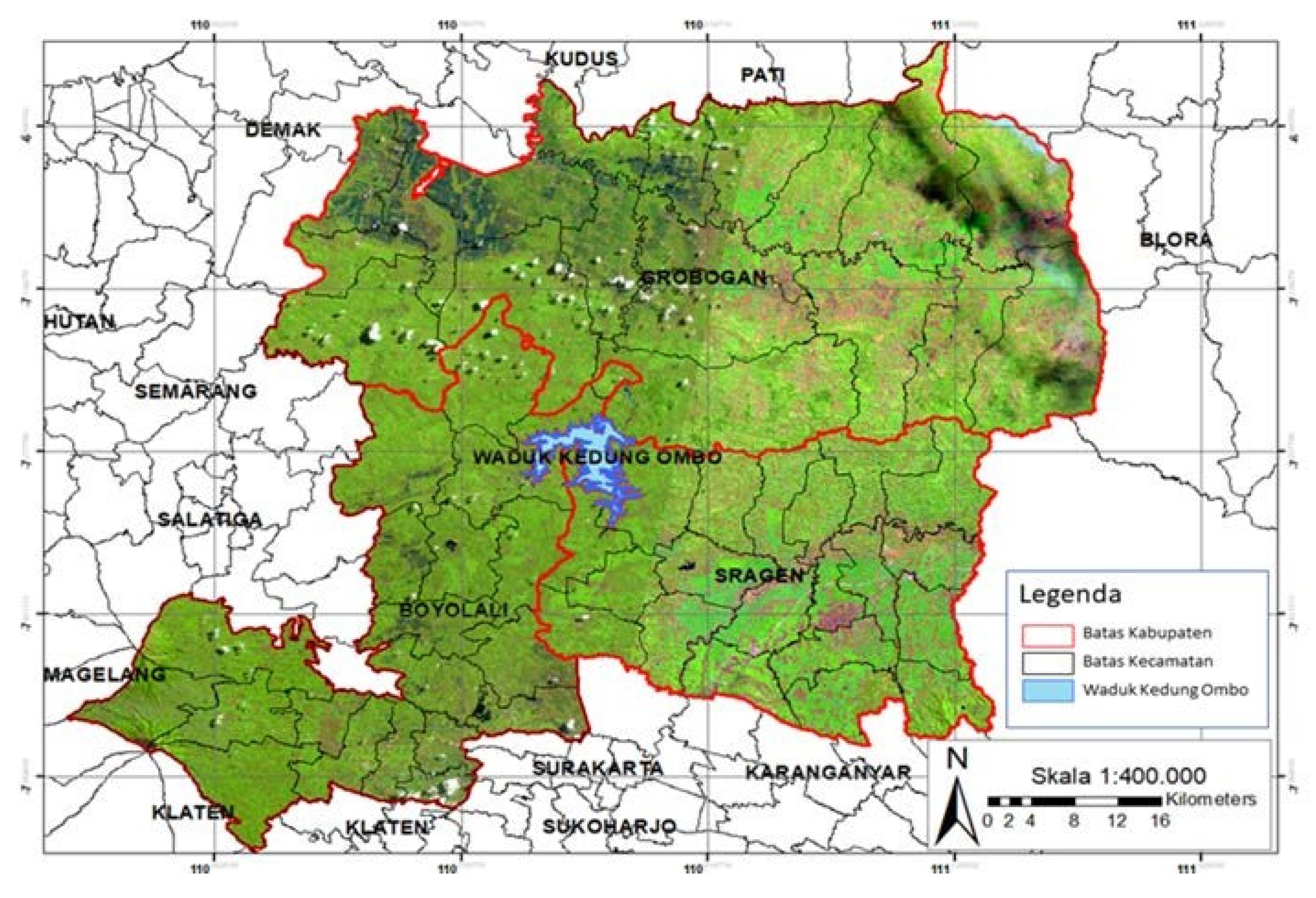
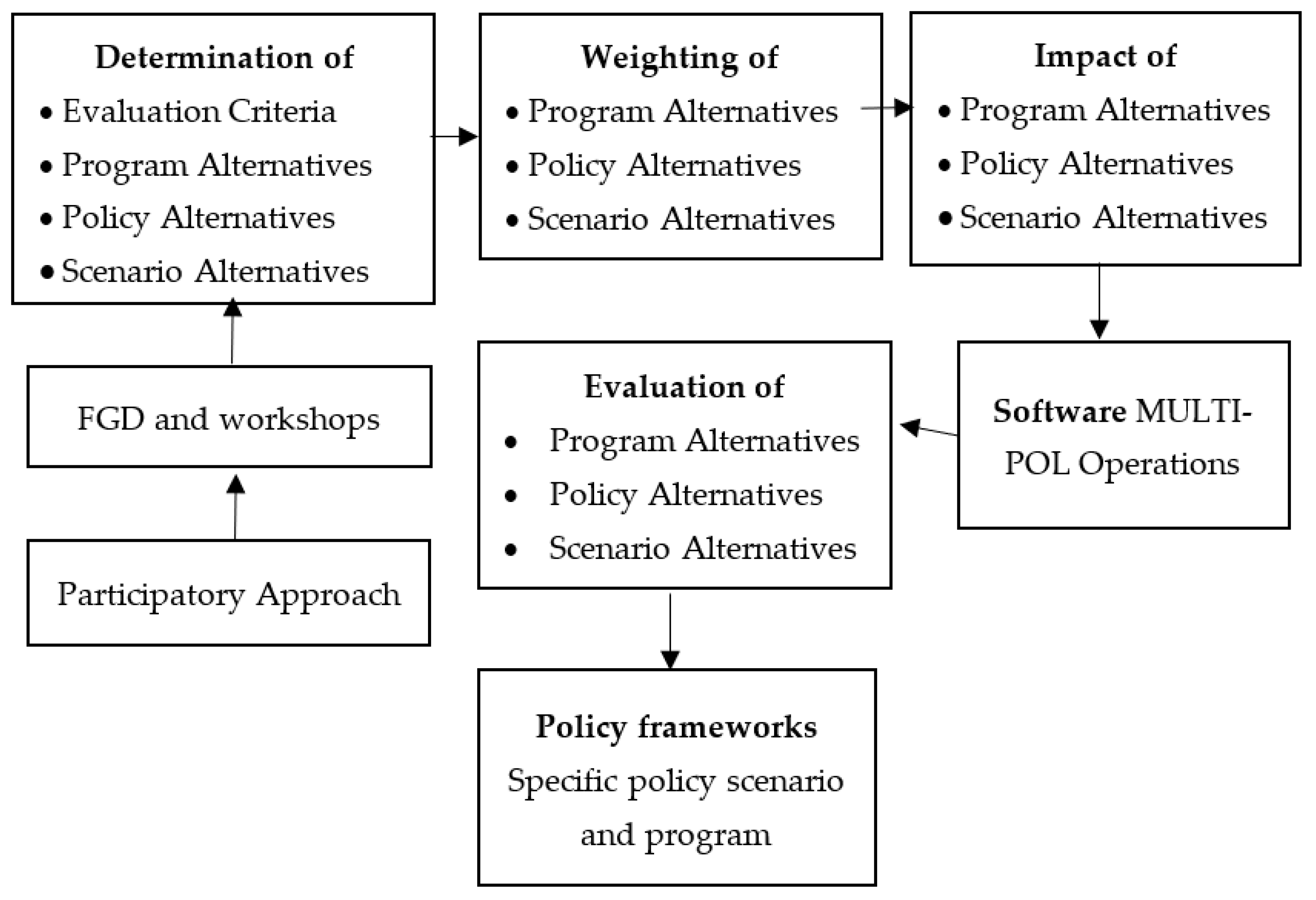
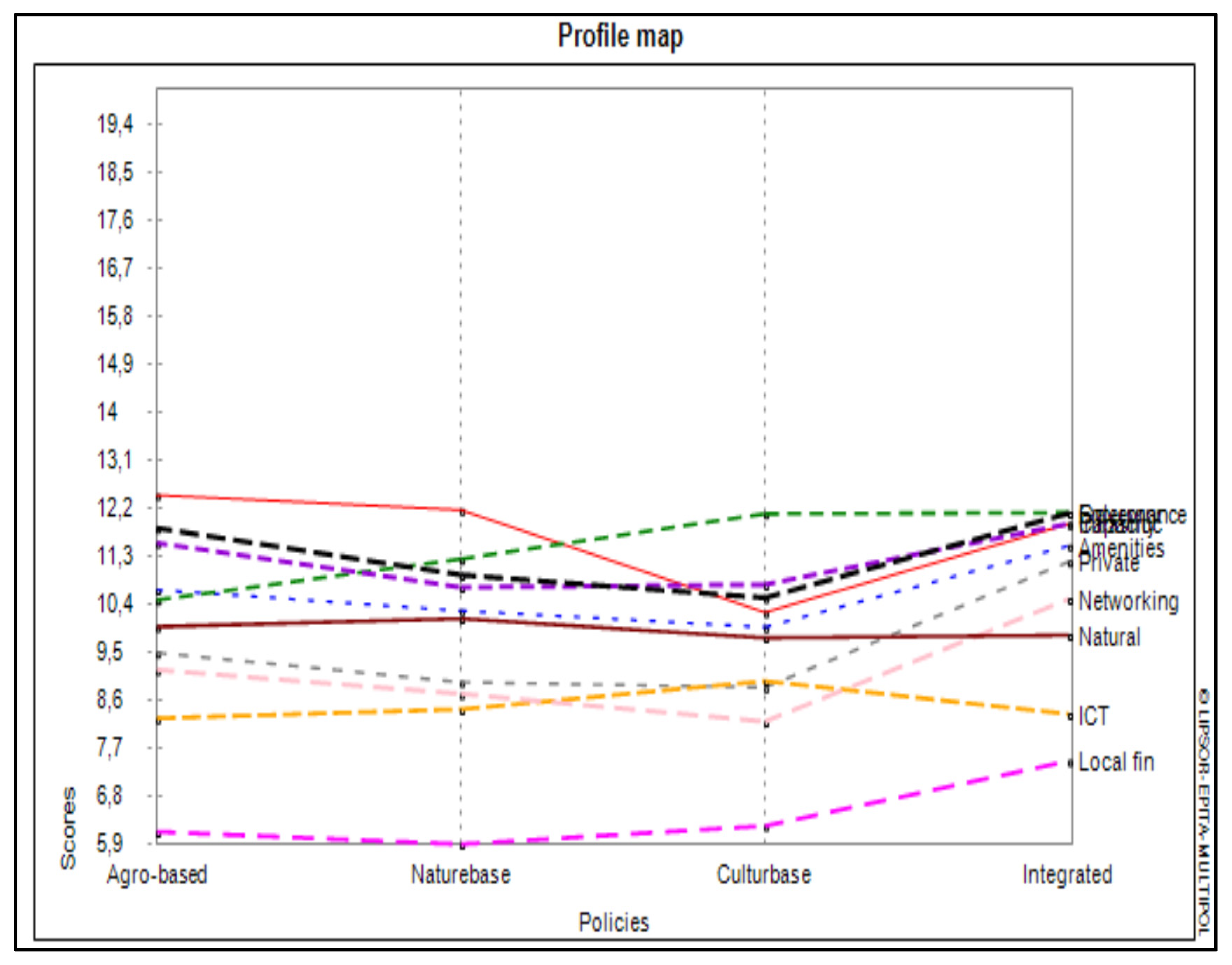
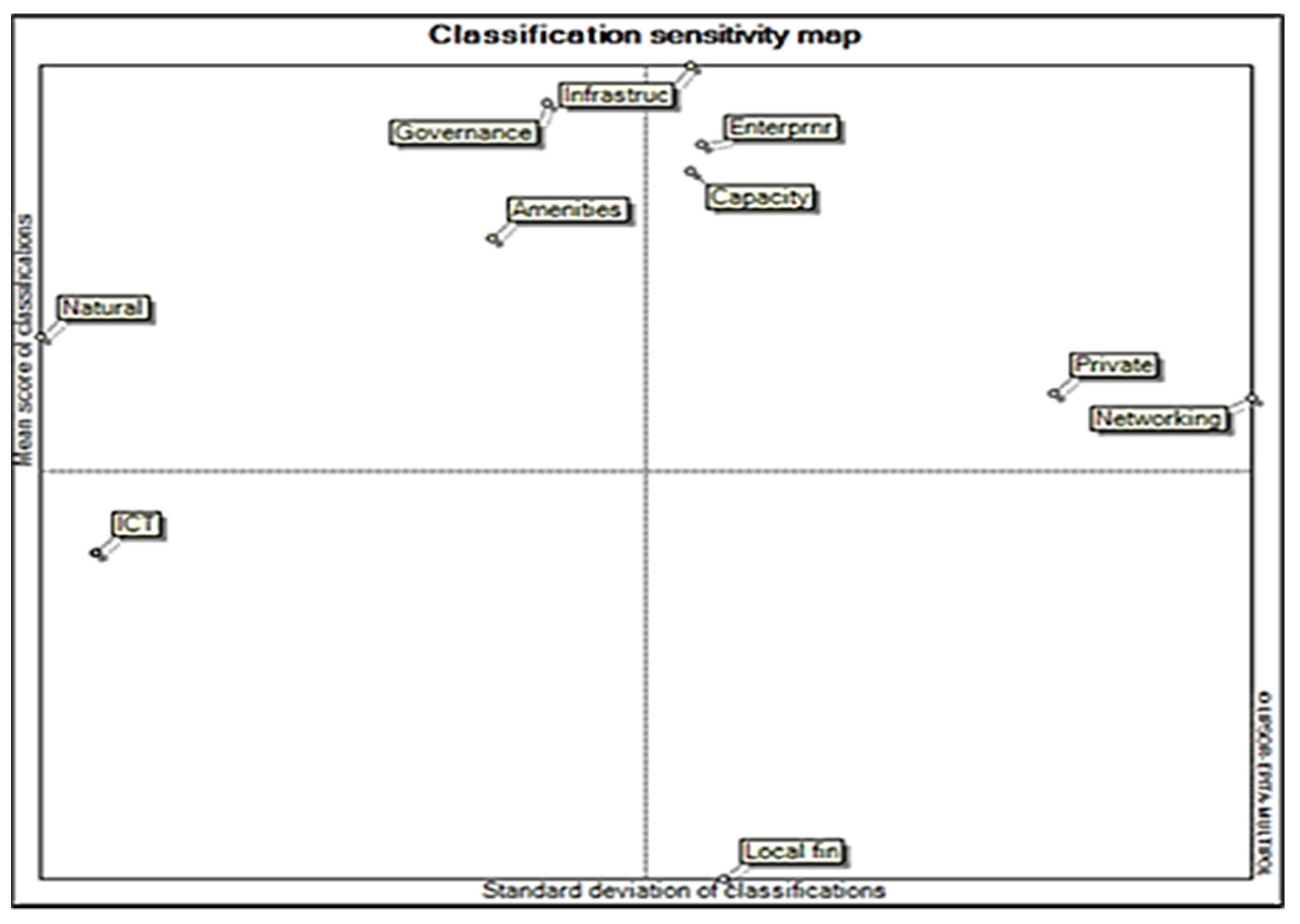
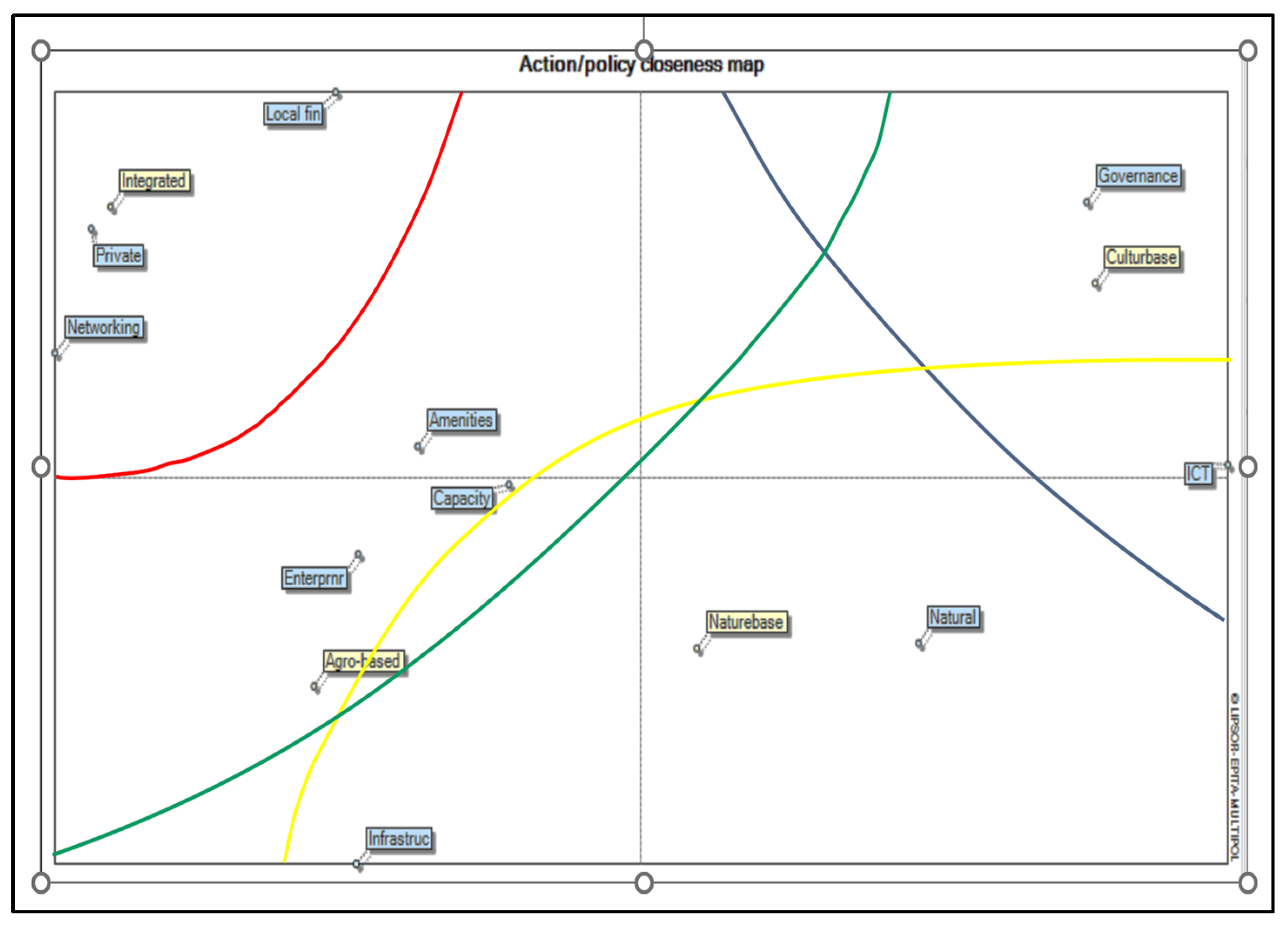
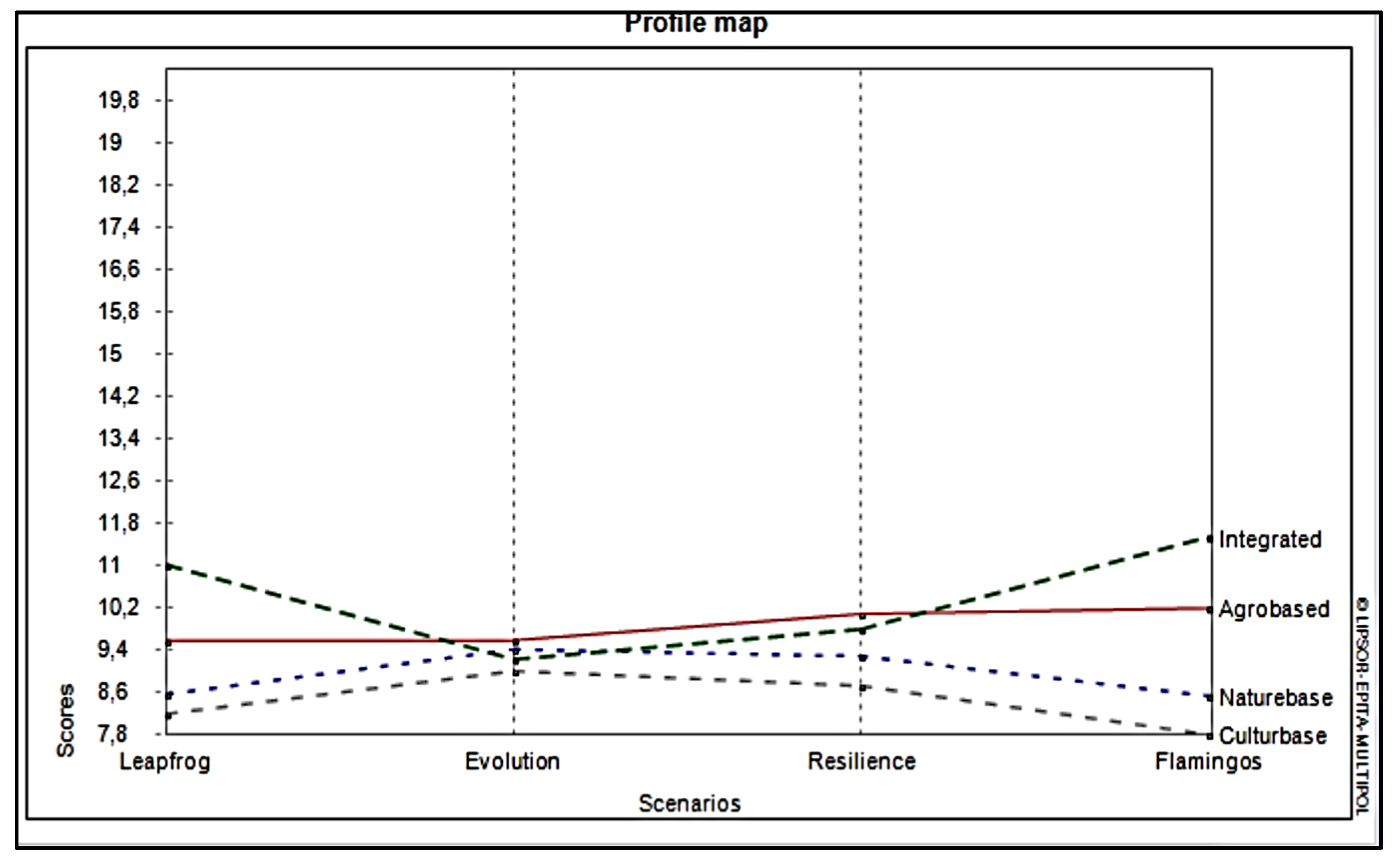
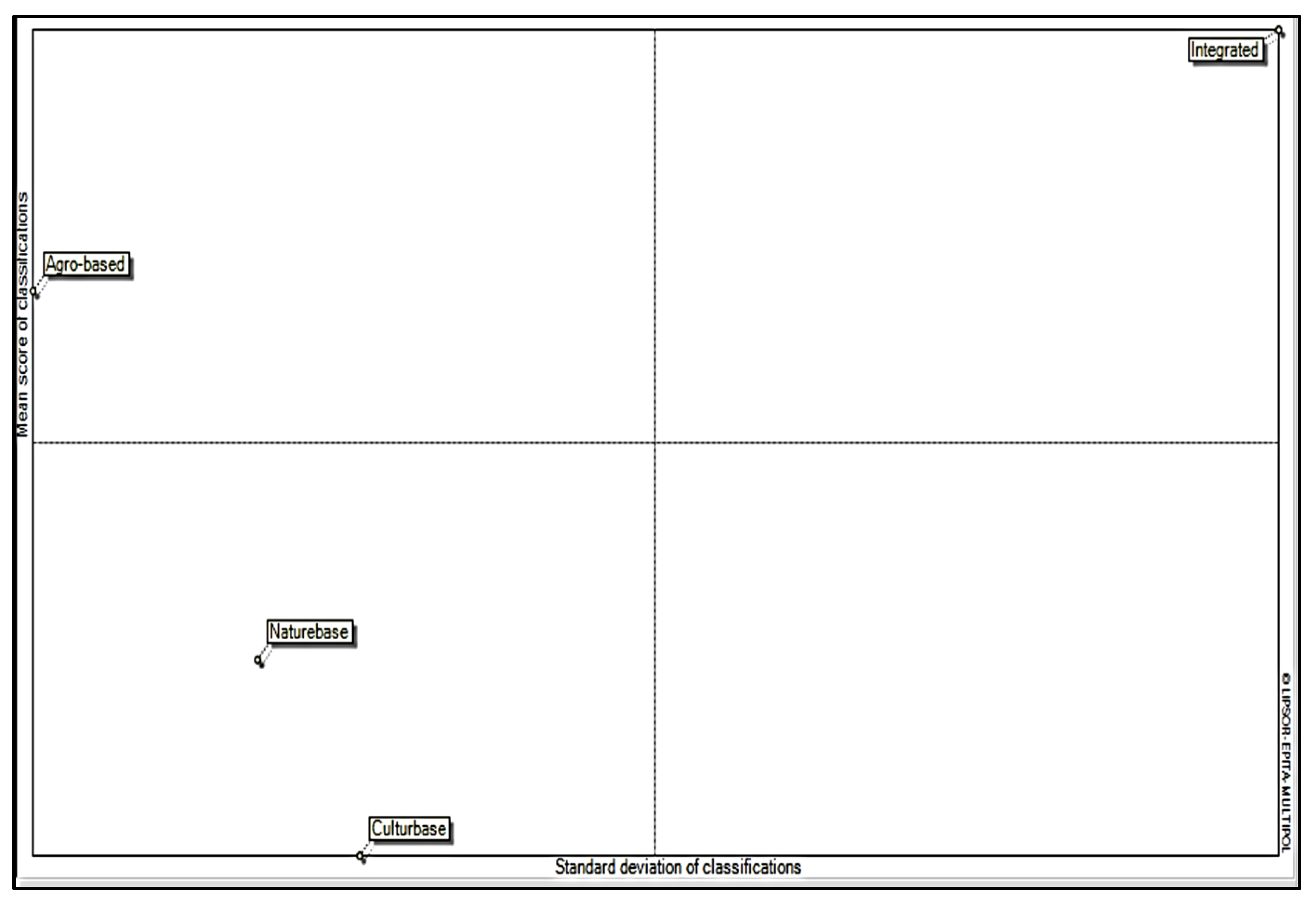
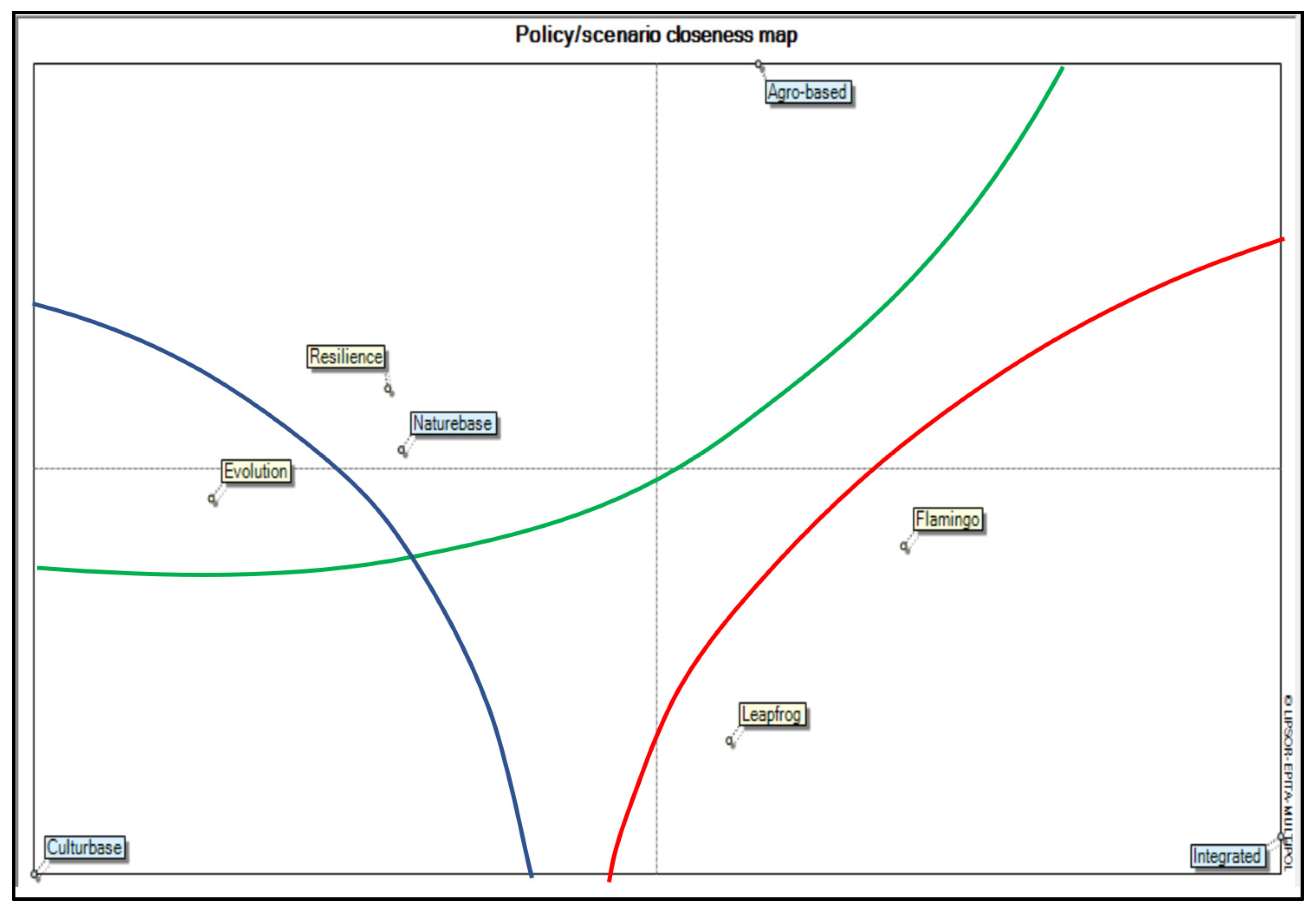
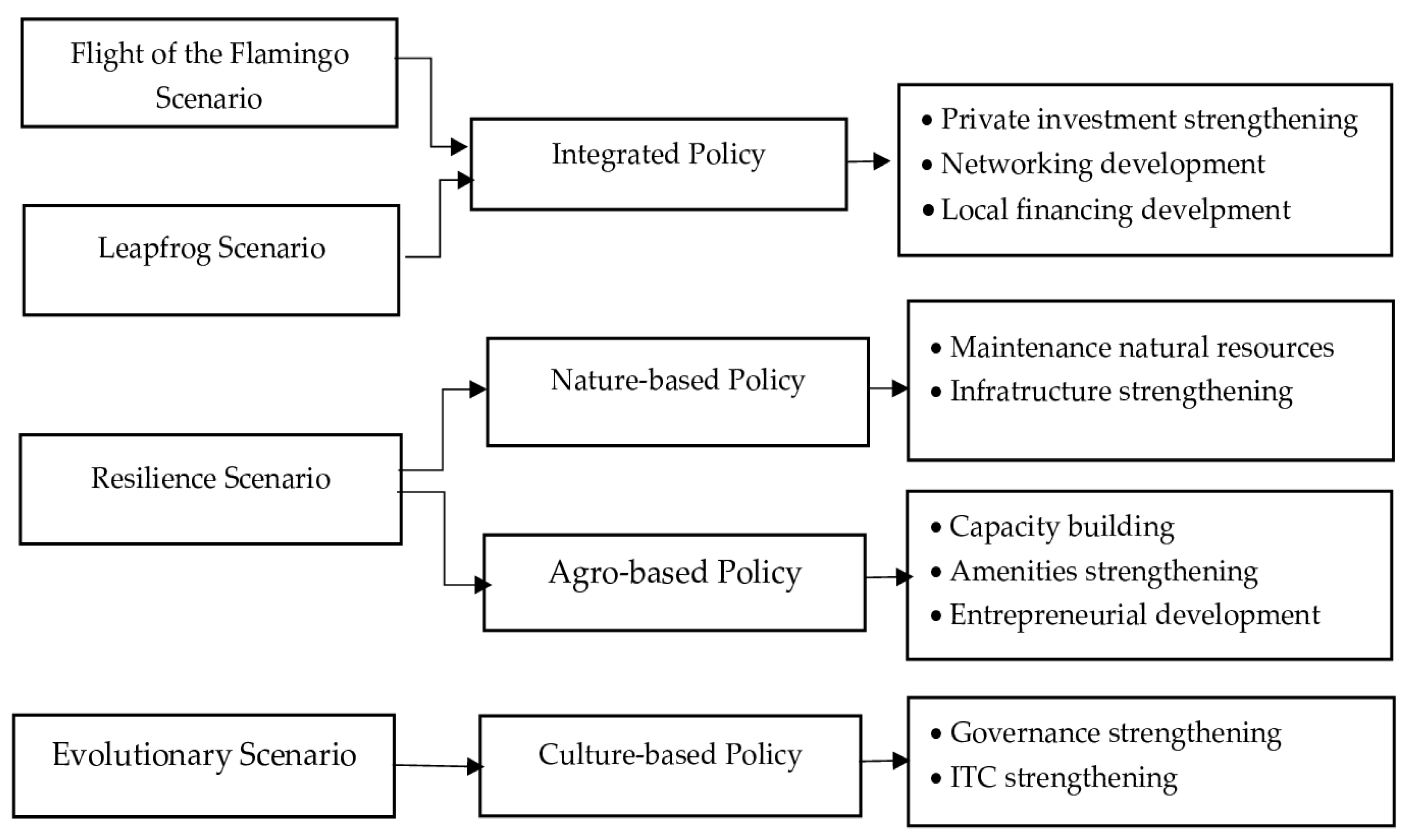
| Criteria | Aspect | Weight | Description |
|---|---|---|---|
| Community income | Economy | 6 | Increase people’s income |
| Regional income | Economy | 6 | Increase regional income |
| Investment | Economy | 6 | Increase investment in the area |
| Employment | Social | 6 | Increase job opportunities |
| Conflict | Social | 5 | Reduce conflict |
| Community competency | Social | 4 | Improving community competence |
| Pollution | Environment | 4 | Reduce pollution |
| Environment degradation | Environment | 6 | Reducing environmental damage |
| Compliance | Institution | 5 | Increase obedience |
| Transparency | Institution | 4 | Increase transparency |
| Accountability | Institution | 4 | Increase accountability |
| Scenario Alternatives | Weight | Description |
|---|---|---|
| Leapfrogging | 5 | The way to achieve the success criteria for tourism development is fast and unpatterned, skipping several stages of the traditional development process to go straight to new development, and it has no link with previous development strategies [69]. |
| Evolutionary | 4 | The way to achieve the success criteria for tourism development is slow and gradual, focusing on how tourism changes through a less dynamic process over time [70]. |
| Resilience | 3 | The way to success in tourism development focuses on efforts to survive internal and external shocks through increased adaptability, innovation, and transformation [71]. |
| Flight of the flamingos | 6 | The comprehensive way to achieve the goals of tourism development success criteria includes social reconstruction, broad participation, good government, and sustainable economic growth [72]. |
| Policy Alternatives | Weight | Description |
|---|---|---|
| Agro-based policy | 5 | The tourism development policies are based on agricultural and plantation products. The Kedung Ombo area is suitable for developing tropical fruits, including longan, tailings, guava, mango, “matoa,” and durian, and for fishing. |
| Nature-based policy | 5 | Tourism development policies are based on natural potential. Many natural potentials in the Kedung Ombo area can be developed as tourist attractions, including the panorama of the vast surface of the reservoir, sunset views, jogging tracks, hills between forests, and camping areas. |
| Culture-based policy | 4 | Tourism development policies are based on cultural potential. In this area, there are several regional arts that have the potential to be developed as tourist attractions. Some of these are “reog”, a traditional dance performed in an open arena with magical elements in which the main dancer is a lion-headed person adorned with peacock feathers, and “campursari,” a musical performance featuring a cross between several genres of contemporary Indonesian music. |
| Integrated policy | 6 | Policies that combine various tourism potentials, resources, and plans from all stakeholders and allow all tourist attractions to be connected. |
| Program Alternative | Description |
|---|---|
| Infrastructure strengthening | Integrated tourism infrastructure development includes area planning, roads, lighting, raw and clean water supply, waste management, sanitation, and residential repairs. |
| Amenities strengthening | Repair and develop tourism facilities such as clinics, halfway houses, places of worship, parking lots, and internet networks. |
| Private investment strengthening | Strengthening involvement and the role of the private sector in developing infrastructure and managing higher-quality tourist destinations. |
| Governance strengthening | Governance strengthening, including coordination, communication, and cooperation between various institutions. |
| Information communication technology (ICT) strengthening | Strengthening technical equipment to process and convey various important information. |
| Capacity building | Development of the skills and capabilities, such as leadership, management, finance and fundraising, marketing, programs, and evaluation, of a community so that the development is effective and sustainable. |
| Entrepreneurship development | Increase entrepreneurial knowledge and skills in the community through structured training programs related to entrepreneurial behavior, dynamics, and tourism business development. |
| Network development | Increase network and cooperation between tourism village managers, communities, educational institutions, and other institutions in various aspects that can support more successful development. |
| Local financial development | Generate financial sources and community financial institutions to establish tourism village self-sufficiency and its development and avoid dependence on government subsidies and other institutions. |
| Maintenance of natural resources | Maintain potential natural resources. Resources included in this category include forests and fisheries. |
| Program/Policy | Agrotourism | Natural Tourism | Culture Tourism | Integrated Tourism | Mean | Deviation Standard | Rank |
|---|---|---|---|---|---|---|---|
| Infrastructure strengthening | 12.4 | 12.2 | 10.2 | 11.9 | 11.8 | 0.8 | 10 |
| Amenities strengthening | 10.6 | 10.1 | 9.9 | 11.5 | 10.6 | 0.6 | 6 |
| Private investment strengthening | 9.5 | 8.3 | 8.8 | 11.2 | 9.6 | 1.1 | 4 |
| Governance strengthening | 10.4 | 11.4 | 12.1 | 12.1 | 11.5 | 0.7 | 9 |
| ICT strengthening | 8.2 | 8.6 | 8.9 | 8.3 | 8.5 | 0.3 | 2 |
| Capacity building | 11.5 | 9.8 | 10.7 | 11.9 | 11.1 | 0.8 | 7 |
| Entrepreneurship development | 11.8 | 10.2 | 10.5 | 12.1 | 11.2 | 0.8 | 8 |
| Network development | 9.1 | 7.5 | 8.2 | 10.5 | 8.9 | 1.1 | 3 |
| Local financial development | 9.1 | 5.2 | 8.2 | 7.4 | 6.3 | 1.6 | 1 |
| Maintenance of natural resources | 9.9 | 10.3 | 9.7 | 9.6 | 9.9 | 0.2 | 5 |
| Policies/Scenario | Leapfrogging | Evolution | Resilience | Flamingos | Mean | Deviation Standard | Rank |
|---|---|---|---|---|---|---|---|
| Agro-based | 9.6 | 9.6 | 10.1 | 10.2 | 9.9 | 0.3 | 3 |
| Nature-based | 8.6 | 9.4 | 9.3 | 8.6 | 8.9 | 0.4 | 2 |
| Culture-based | 8.2 | 9 | 8.8 | 7.8 | 8.4 | 0.4 | 1 |
| Integrated | 11.1 | 9.3 | 9.8 | 11.6 | 10.6 | 0.9 | 4 |
Disclaimer/Publisher’s Note: The statements, opinions and data contained in all publications are solely those of the individual author(s) and contributor(s) and not of MDPI and/or the editor(s). MDPI and/or the editor(s) disclaim responsibility for any injury to people or property resulting from any ideas, methods, instructions or products referred to in the content. |
© 2023 by the authors. Licensee MDPI, Basel, Switzerland. This article is an open access article distributed under the terms and conditions of the Creative Commons Attribution (CC BY) license (https://creativecommons.org/licenses/by/4.0/).
Share and Cite
Ariyani, N.; Fauzi, A. Pathways toward the Transformation of Sustainable Rural Tourism Management in Central Java, Indonesia. Sustainability 2023, 15, 2592. https://doi.org/10.3390/su15032592
Ariyani N, Fauzi A. Pathways toward the Transformation of Sustainable Rural Tourism Management in Central Java, Indonesia. Sustainability. 2023; 15(3):2592. https://doi.org/10.3390/su15032592
Chicago/Turabian StyleAriyani, Nafiah, and Akhmad Fauzi. 2023. "Pathways toward the Transformation of Sustainable Rural Tourism Management in Central Java, Indonesia" Sustainability 15, no. 3: 2592. https://doi.org/10.3390/su15032592
APA StyleAriyani, N., & Fauzi, A. (2023). Pathways toward the Transformation of Sustainable Rural Tourism Management in Central Java, Indonesia. Sustainability, 15(3), 2592. https://doi.org/10.3390/su15032592







